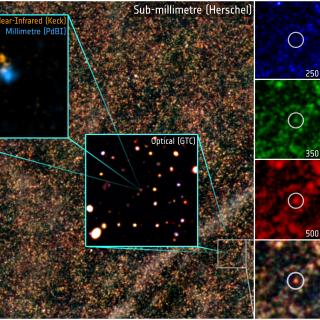Bibcode
Langeroodi, Danial; Hjorth, Jens; Chen, Wenlei; Kelly, Patrick L.; Williams, Hayley; Lin, Yu-Heng; Scarlata, Claudia; Zitrin, Adi; Broadhurst, Tom; Diego, Jose M.; Huang, Xiaosheng; Filippenko, Alexei V.; Foley, Ryan J.; Jha, Saurabh; Koekemoer, Anton M.; Oguri, Masamune; Perez-Fournon, Ismael; Pierel, Justin; Poidevin, Frederick; Strolger, Lou
Bibliographical reference
The Astrophysical Journal
Advertised on:
11
2023
Journal
Citations
90
Refereed citations
70
Description
A tight positive correlation between the stellar mass and the gas-phase metallicity of galaxies has been observed at low redshifts. The redshift evolution of this correlation can strongly constrain theories of galaxy evolution. The advent of JWST allows probing the mass-metallicity relation at redshifts far beyond what was previously accessible. Here we report the discovery of two emission line galaxies at redshifts 8.15 and 8.16 in JWST NIRCam imaging and NIRSpec spectroscopy of targets gravitationally lensed by the cluster RX J2129.4+0005. We measure their metallicities and stellar masses along with nine additional galaxies at 7.2 < z spec < 9.5 to report the first quantitative statistical inference of the mass-metallicity relation at z ≈ 8. We measure ~0.9 dex evolution in the normalization of the mass-metallicity relation from z ≈ 8 to the local universe; at a fixed stellar mass, galaxies are 8 times less metal enriched at z ≈ 8 compared to the present day. Our inferred normalization is in agreement with the predictions of FIRE simulations. Our inferred slope of the mass-metallicity relation is similar to or slightly shallower than that predicted by FIRE or observed at lower redshifts. We compare the z ≈ 8 galaxies to extremely low-metallicity analog candidates in the local universe, finding that they are generally distinct from extreme emission line galaxies or "green peas," but are similar in strong emission line ratios and metallicities to "blueberry galaxies." Despite this similarity, at a fixed stellar mass, the z ≈ 8 galaxies have systematically lower metallicities compared to blueberry galaxies.
Related projects

Anisotropy of the Cosmic Microwave Background
The general goal of this project is to determine and characterize the spatial and spectral variations in the temperature and polarisation of the Cosmic Microwave Background in angular scales from several arcminutes to several degrees. The primordial matter density fluctuations which originated the structure in the matter distribution of the present
Rafael
Rebolo López

Formation and Evolution of Galaxies: Observations in Infrared and other Wavelengths
This IAC research group carries out several extragalactic projects in different spectral ranges, using space as well as ground-based telescopes, to study the cosmological evolution of galaxies and the origin of nuclear activity in active galaxies. The group is a member of the international consortium which built the SPIRE instrument for the
Ismael
Pérez Fournon